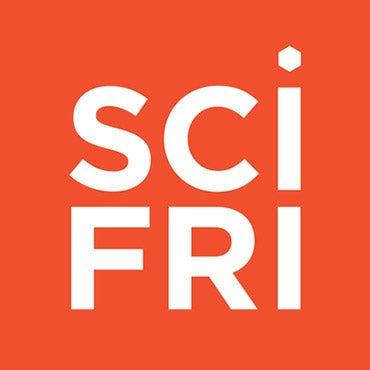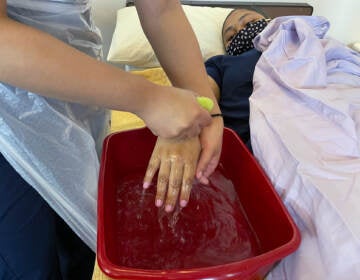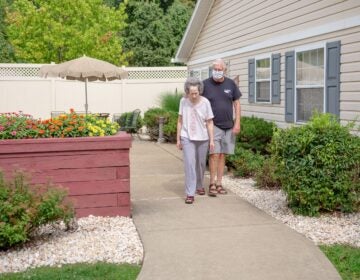Low pay is causing a staffing crisis for disability care. Advocates say Pa.’s plan to raise wages isn’t enough
A staffing shortage has left people with intellectual and developmental disabilities without essential services and their families without desperately needed help.
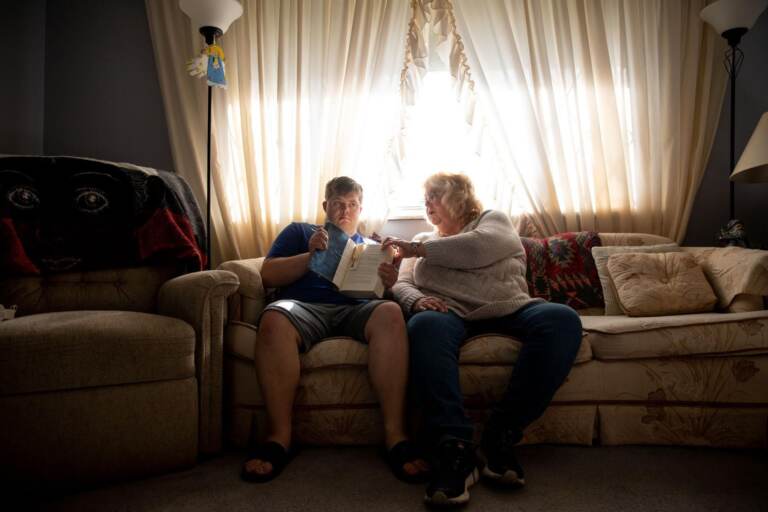
Lisa Stagon had to quit her job to care for her son Chris, who is 26 and has Down syndrome. (Kaycee Orwig/PublicSource)
This story originally appeared on Spotlight PA.
Before the pandemic, Lisa Stagon and her son Chris had their care routine figured out. Chris, who is 26 and has Down syndrome, worked part-time at an Eat’n Park in Westmoreland County, received monthly job training, and spent 46 hours a week with a direct support professional while his mother was at work.
But their structure began to crumble during the pandemic when Chris was laid off and Stagon, fearing Chris could contract COVID-19 through a caregiver, suspended his services. Suddenly Chris was home all day, without any support.
“I was working 50 hours a week and trying to care for him at the same time,” Stagon, 62, said. “It was a lot.”
The breaking point came when Stagon was called back to the office last year after working remotely. She tried to find someone to help Chris with everyday tasks like shaving, cooking, and taking his medications. But agencies across the region were turning families away. There simply wasn’t anyone to do the job.
In July 2020, she made a difficult decision.
“I left the workforce in the pandemic to be a full-time caretaker for him,” she said. “Because it was just — it was too hard.”
Pennsylvania is facing a dire shortage of direct support professionals who help people with intellectual and developmental disabilities bathe, get dressed, eat, exercise, socialize, and perform many other fundamental tasks. Putting an exact number on the shortfall is difficult, as employment data on these workers is lumped together with health-care aides generally, but the industry was already experiencing double-digit vacancy and turnover rates nationally before COVID-19 arrived.
The shortage has left thousands of people without essential services and their families without desperately needed help.
Many providers and families blame the staffing crisis on skimpy government funding. The state’s reimbursement rates for support services, they said, are too low to pay a living wage to professional caregivers, making hiring and retaining workers nearly impossible.
In some cases, families waited years to receive funding from the state for those services only to find there is no one to provide them.
As of September, there were over 12,000 people with an intellectual disability in need of financial help on a state waitlist for funding, according to Brandon Cwalina, a spokesperson for Pennsylvania’s Department of Human Services,
The wait for those who sign up is an average of over two years, and patient advocates say there are likely many more families who need services but aren’t on the waitlist.
“Now we have families who … finally got the funding for the services they need, and we can’t provide them with those services because we can’t recruit and retain staff,” said Nancy Murray, senior vice president of Achieva, a disability services provider in Southwestern Pennsylvania. “In my career, I never thought we’d get to this point.”
Before the pandemic, there was already an urgent national shortage of professional caregivers, largely due to low pay and a rapidly aging population that outpaces the growth of the direct care workforce. Now, service providers and families say the problem has worsened.
“We used to call this a crisis,” Murray said. “Now we’re beginning to see the whole system just crumble and start to collapse.”
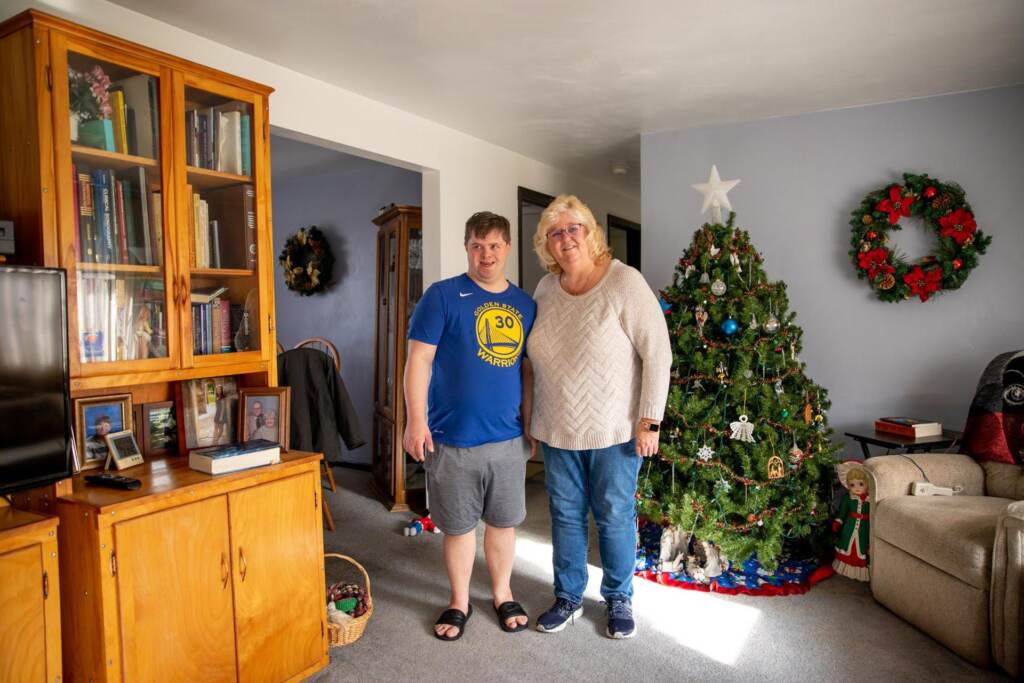
One Pittsburgh mom said she has been looking for three years for a caregiver for her son, who lives with autism. In Westmoreland County, a family hasn’t been able to find services for their daughter, who requires 24/7 care, since the program she went to every day shut down at the beginning of the pandemic.
Two studies from 2019 and 2021 conducted by groups representing providers found the average hourly rate for support professionals in Pennsylvania to be around $13 or $14. That’s in line with the national average, according to PHI, a national research and advocacy organization for direct care workers.
And with businesses fighting to attract workers amid a national labor shortage, the organizations that employ support professionals simply can’t compete.
“They can go and make more money at Lowe’s or almost anywhere,” said Karen Jacobsen, executive director of Emmaus Community of Pittsburgh, a disability services provider in the Pittsburgh region. “Walmart, Olive Garden, you name it.”
Patrick DeMico of The Provider Alliance in Westmoreland County describes a chicken-and-the-egg dilemma, linking low staffing levels to low pay, and the low pay to the low reimbursement rates offered by the state’s Medicaid program, a primary funder of such services.
“The state is essentially the sole source of funding for providers, so unless there is sufficient funding in the rates, they cannot afford to pay competitive wages to [direct support professionals],” DeMico said. “The vast majority of spending by providers is for DSP compensation.”
As part of a $1.2 billion plan to address the industry’s concerns, the state said it will increase the reimbursement rate to a level that would allow providers to pay $15 an hour on average. Providers were quick to critique that part of the plan as too small to truly turn the tide.
Additionally, they say further rate hikes will be needed to sustain any positive impacts on staffing levels, and that would require consensus in future state budget cycles, something providers are wary of counting on from Harrisburg.
“Unless they act … this is a 10-alarm fire. People’s lives are at risk,” said Gary Blumenthal of InVision Human Services, a nonprofit service provider for people with intellectual disabilities.
In the meantime, families are left without help.
Though she is compensated for her work as Chris’ caregiver through the same state program that helps families pay for professional services, Stagon said leaving her job meant a loss of pay that significantly impacted the family’s budget. While Chris is back at work part-time, Stagon still provides care for him.
More than anything, Stagon is concerned about getting older.
“I worry every single day, if something happens to me,” she said, “what’s going to happen to him?”
‘Severe shortage’
Lately, 90-hour workweeks have become the norm for Lauren Zak.
The direct support professional for Emmaus Community of Pittsburgh usually cares for four people. But because the organization is so short-staffed, Zak said she’s been bouncing between clients and can see up to 10 different people in a month, sometimes with very little notice.
“People are leaving, trying to find jobs they can live off of,” Zak said.
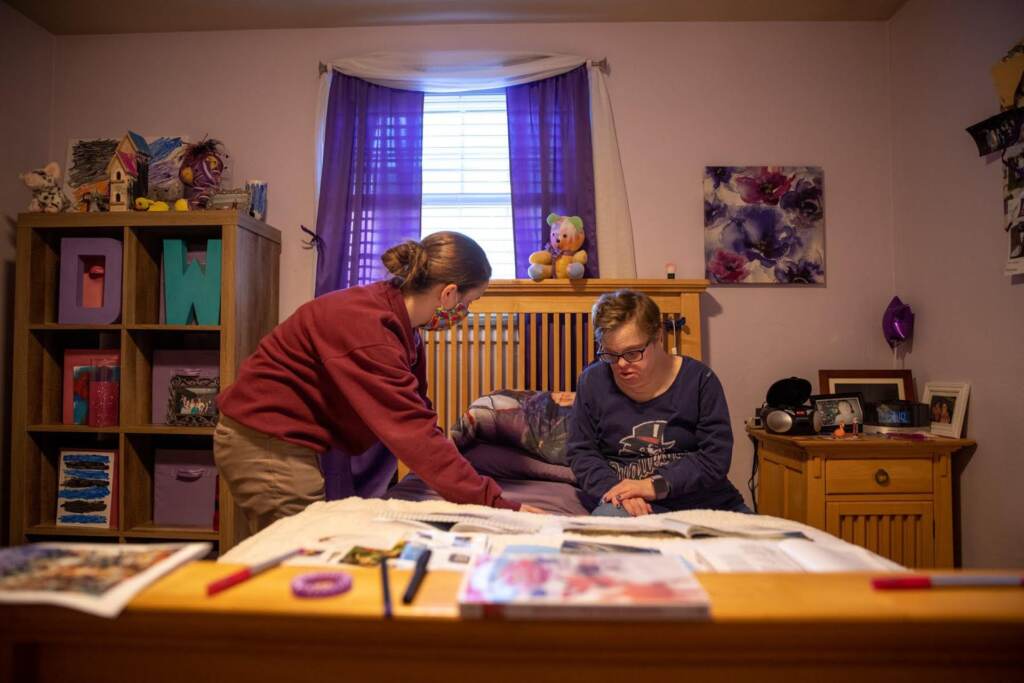
The workforce shortage has loomed for years. A 2013 report from the federal Centers for Medicare & Medicaid Services predicted the demand for direct service workers in the United States would increase by nearly half between 2010 and 2020, due to an increase in the aging population and a growing preference for home-based care. That — paired with low average wages, a lack of training, and other recruitment challenges — would result in “a severe shortage of employees,” the report predicted.
And that was before the pandemic. Now, the shortage is so severe that three out of four providers are turning potential clients away, and more than half of providers are discontinuing programs and services, according to the American Network of Community Options and Resources, a trade association for providers. Jacobsen, the executive director of Emmaus, said the organization is so short-staffed she’s been stepping in to cover shifts herself.
“And I’m not alone,” she said. “There are many, many, many CEOs filling shifts right now.”
A partial fix
Pennsylvania’s response is backed by $1.2 billion in enhanced Medicaid funding made available through the American Rescue Plan Act, a COVID-19 stimulus package signed into law by President Joe Biden in March.
A spending strategy outlined by Pennsylvania’s Department of Human Services includes hundreds of millions of dollars to certify more caretakers, help bankroll new hires, get respite care to waitlisted families, and more. But almost all of it is in temporary or one-time payments.
The item providers say would have the greatest long-term potential, a hike of Medicaid reimbursement rates, is significantly smaller than expected.
While providers had lobbied for rates high enough to push their average hourly wage to $18 or $19, an amount they say is necessary to begin attracting workers and compete with state-run centers serving people with disabilities, the department’s plan would only raise it a dollar or two — in this case, to roughly $15 an hour.
“I am profoundly disappointed in the Wolf administration’s wholly inadequate response to the absolute crisis that is harming the most vulnerable in our state,” Blumenthal said of the rate hike.
In an email to PublicSource and Spotlight PA, the Department of Human Services called the proposed hike an “unprecedented opportunity,” noting rates are set in accordance with state code and that this update was initiated a year ahead of schedule. The department added that it cannot provide abnormally high rate hikes for one program without first “considering the impact that would have on the entire system.”
The rate increase is the first in four years and is in the final stages of review. It’s expected to take effect in January or February, and will cost $400 million in state and federal funding annually.
The industry says continued rate increases will be necessary to rebuild and sustain the workforce going forward, but it remains to be seen whether state lawmakers will agree when it comes time for future budget negotiations.
The outlook is also uncertain for billions in targeted aid included in Biden’s imperiled Build Back Better plan, which was approved by the U.S. House but remains stalled in the U.S. Senate.
The office of Gov. Tom Wolf, who is serving his final term, said it hopes to see investments continue under future gubernatorial administrations and the legislature. Leaders of Pennsylvania’s Republican majority declined to comment.
Democratic lawmakers have tussled with Republicans over the latter party’s decision to shelve billions in federal COVID-19 relief money — funds the Democrats argue are needed to shore up social, health-care, and economic safety nets at a time of historic demand.
Wolf ultimately approved the savings plan by signing the state’s 2021-22 budget into law.
With that money in a rainy day fund, Democrats say there is a moral imperative before them.
“It’s not enough to put a sign in the yard that says, ‘Health Care Heroes Work Here.’ We show people how we value them by what we do for their pocketbooks,” said state Sen. Maria Collett (D., Montgomery), a former long-term care nurse and minority chair of the state Senate’s Aging & Youth Committee.
Family members of people with intellectual disabilities hope state leaders and lawmakers will realize how vital these services are — and prioritize them accordingly.
“Why do we have to fight so hard for everything our child needs and receives? It’s always a fight,” said Stagon. “They’re needy individuals of the state, and they’re not being taken care of.”
This story is a collaboration between Spotlight PA and PublicSource.
 Spotlight PA is an independent, non-partisan newsroom powered by The Philadelphia Inquirer in partnership with PennLive/The Patriot-News, TribLIVE/Pittsburgh Tribune-Review, and WITF Public Media.
Spotlight PA is an independent, non-partisan newsroom powered by The Philadelphia Inquirer in partnership with PennLive/The Patriot-News, TribLIVE/Pittsburgh Tribune-Review, and WITF Public Media.
WHYY is your source for fact-based, in-depth journalism and information. As a nonprofit organization, we rely on financial support from readers like you. Please give today.

